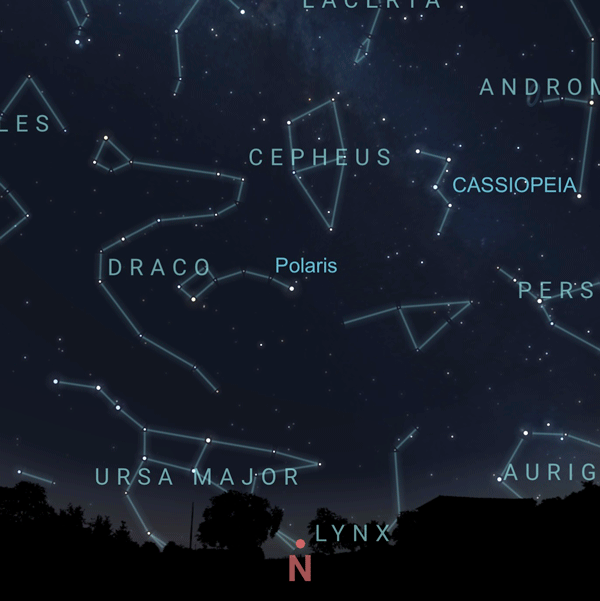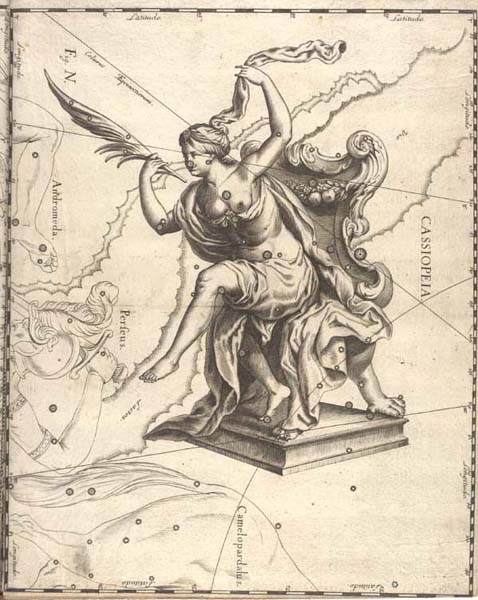Cassiopeia overhead on autumn evenings
The constellation Cassiopeia the Queen can be found high in the sky on October and November evenings, not far from Polaris, the North Star. At any time of year, you can use the Big Dipper to find Cassiopeia. These two star formations are like riders on opposite sides of a Ferris wheel. They’re part of a great spinning wheel of stars seen moving counterclockwise around Polaris, the North Star, once each day. As Cassiopeia rises upward, the Big Dipper plunges downward, and vice versa.
Some of you know how to star-hop to Polaris, the North Star, by using the Big Dipper’s pointer stars, as displayed on the sky chart below. Because the Big Dipper’s handle and Cassiopeia shine on opposite sides of Polaris, an imaginary line from any star on the Big Dipper handle through Polaris reliably points to Cassiopeia.

The 2024 lunar calendars are here! Best Christmas gifts in the universe! Check ’em out here.
Cassiopeia is bright and easy to pick out in the sky
However, you won’t need the Big Dipper and Polaris to find Cassiopeia. That’s because Cassiopeia is very easy to pick out. It’s small and compact and looks like the letter M or W, depending on the time of night and time of year.
Like the Big Dipper, Cassiopeia can be seen even on moonlit nights.
Bonus for you if you live north of about 40 degrees north latitude, about the latitude of New York City! From that latitude and farther north, the Big Dipper and Cassiopeia are both circumpolar. That means they’re always above the horizon at any time of night, all year round.

Star lore of Cassiopeia
Cassiopeia used to be known among astronomers and skywatchers alike as Cassiopeia’s Chair. In the 1930s, the International Astronomical Union gave this constellation the official name of Cassiopeia the Queen.
Cassiopeia was a queen in ancient Greek mythology. According to legend, she boasted she was more beautiful than the sea nymphs called the Nereids. Her boast angered Poseidon, god of the sea, who sent a sea monster, Cetus, to ravage the kingdom. To pacify the monster, Cassiopeia’s daughter, Princess Andromeda, was left tied to a rock by the sea. Cetus was about to devour her when Perseus the Hero looked down upon her from Pegasus, the Flying Horse. Perseus rescued the Princess, and all lived happily.
The gods were so pleased, that all of these characters were elevated to the heavens as stars. Only Cassiopeia suffered an indignity; her vanity caused her to be bound to a chair and placed in the heavens so that, as she revolves around the north celestial pole, she is sometimes in an upside-down position.

Bottom line: Spot the constellation Cassiopeia the Queen somewhere in the northern sky during much of the year, and throughout much of the night.
The post Cassiopeia the Queen is overhead on autumn evenings first appeared on EarthSky.
from EarthSky https://ift.tt/TFmVxJZ
Cassiopeia overhead on autumn evenings
The constellation Cassiopeia the Queen can be found high in the sky on October and November evenings, not far from Polaris, the North Star. At any time of year, you can use the Big Dipper to find Cassiopeia. These two star formations are like riders on opposite sides of a Ferris wheel. They’re part of a great spinning wheel of stars seen moving counterclockwise around Polaris, the North Star, once each day. As Cassiopeia rises upward, the Big Dipper plunges downward, and vice versa.
Some of you know how to star-hop to Polaris, the North Star, by using the Big Dipper’s pointer stars, as displayed on the sky chart below. Because the Big Dipper’s handle and Cassiopeia shine on opposite sides of Polaris, an imaginary line from any star on the Big Dipper handle through Polaris reliably points to Cassiopeia.

The 2024 lunar calendars are here! Best Christmas gifts in the universe! Check ’em out here.
Cassiopeia is bright and easy to pick out in the sky
However, you won’t need the Big Dipper and Polaris to find Cassiopeia. That’s because Cassiopeia is very easy to pick out. It’s small and compact and looks like the letter M or W, depending on the time of night and time of year.
Like the Big Dipper, Cassiopeia can be seen even on moonlit nights.
Bonus for you if you live north of about 40 degrees north latitude, about the latitude of New York City! From that latitude and farther north, the Big Dipper and Cassiopeia are both circumpolar. That means they’re always above the horizon at any time of night, all year round.

Star lore of Cassiopeia
Cassiopeia used to be known among astronomers and skywatchers alike as Cassiopeia’s Chair. In the 1930s, the International Astronomical Union gave this constellation the official name of Cassiopeia the Queen.
Cassiopeia was a queen in ancient Greek mythology. According to legend, she boasted she was more beautiful than the sea nymphs called the Nereids. Her boast angered Poseidon, god of the sea, who sent a sea monster, Cetus, to ravage the kingdom. To pacify the monster, Cassiopeia’s daughter, Princess Andromeda, was left tied to a rock by the sea. Cetus was about to devour her when Perseus the Hero looked down upon her from Pegasus, the Flying Horse. Perseus rescued the Princess, and all lived happily.
The gods were so pleased, that all of these characters were elevated to the heavens as stars. Only Cassiopeia suffered an indignity; her vanity caused her to be bound to a chair and placed in the heavens so that, as she revolves around the north celestial pole, she is sometimes in an upside-down position.

Bottom line: Spot the constellation Cassiopeia the Queen somewhere in the northern sky during much of the year, and throughout much of the night.
The post Cassiopeia the Queen is overhead on autumn evenings first appeared on EarthSky.
from EarthSky https://ift.tt/TFmVxJZ

Aucun commentaire:
Enregistrer un commentaire